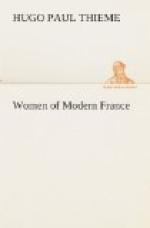The marriage customs in these circles differed little from those of to-day. The suitor asked permission to call and to continue his visits; then followed the period of present giving. The young girl was almost always absolute mistress of the decision; if the father presented a name, the daughter insisted upon seeing, receiving, and becoming intimately acquainted with the suitor, a custom quite different from that practised among the nobility. Instead of giving her rights as it did the girl of the nobility, marriage imposed duties upon the girl of the middle class; it closed the world instead of opening it to her; it ended her brilliant, gay, and easy life, instead of beginning it, as was the case in the higher classes. This she realized, therefore hesitated long before taking the final step which was to bind her until death.
With her, becoming a wife meant infinitely more than it did to the girl of the nobility; her husband had the management of her money, and his vices were visited upon her and her children—in short, he became her master in all things. These disadvantages she was taught to consider deeply before entering the marriage state.
This state of affairs developed distinctive physiognomies in the different classes of the middle-class society: thus, “the wives of the financiers are dignified, stern, severe; those of the merchants are seductive, active, gossiping, and alert; those of the artists are free, easy, and independent, with a strong taste for pleasure and gayety—and they give the tone.” As we approach the end of the century, the bourgeoisie begins to assume the airs, habits, extravagances, and even the immoralities, of the higher classes.
Below the bourgeoise was the workingwoman, whose ideas were limited to those of a savage and who was a woman only in sex. Her ideas of morality, decency, conjugal happiness, children, education, were limited by quarrels, profanity, blows, fights. At that time brandy was the sole consolation for those women; it supplied their moral force and their moral resistance, making them forget cold, hunger, fatigue, evil, and giving them courage and patience; it was the fire that sustained, comforted, and incited them.
These women were not much above the level of animals, but from them, we find, often sprang the entertainers of the time, the queens of beauty and gallantry—Laguerre, D’Hervieux, Sophie Arnould. Having lost their virtue with maturity, these women had no sense of morality; in them, nothing preserved the sense of honor—their religion consisted of a few superstitious practices. The constituents of duty and the virtue of women they could only vaguely guess; marriage itself was presented to them under the most repugnant image of constant contention.
It was in such an atmosphere as this that the daughters of these women grew up. Their talents found opportunity for display at the public dances where some of them would in time attract especial attention. Some became opera singers, dancers, or actresses, and were very popular; others became influential, and, through the efforts of some lover, allured about them a circle of ambitious debauches or aspirants for social favors. Through their adventures they made their way up in the world to high society.




